Durable Decking Materials

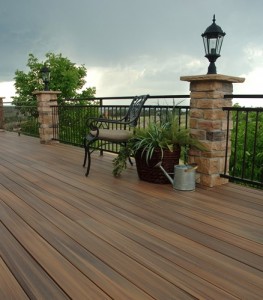 Adding a deck is one of the most requested home improvement projects. Decks can extend your entertaining space by creating an enjoyable outdoor spot for dining, grilling or lounging. An elevated deck (rather than a ground-level patio) is an ideal solution for sloped yards where a flat area is wanted. Most decks tend to be located in proximity to the kitchen—an important site consideration when cooking outdoors.
Adding a deck is one of the most requested home improvement projects. Decks can extend your entertaining space by creating an enjoyable outdoor spot for dining, grilling or lounging. An elevated deck (rather than a ground-level patio) is an ideal solution for sloped yards where a flat area is wanted. Most decks tend to be located in proximity to the kitchen—an important site consideration when cooking outdoors.
One of the biggest decisions you’ll make about your new deck is selecting the material to construct it. A professional deck builder from Composite Decking | FutureWood can make recommendations about materials, size and style and any additional structures you could add to enhance the deck and integrate it into your home’s exterior. Decking Ipswich builders work with landscapers, pool companies and other outdoor professionals to create an outdoor entertaining space that truly “elevates” the appearance and functionality of a backyard deck. Use these veranda decking maintenance tips, including cleaning, staining, and repairing damaged boards.
Know Your Materials
There are three main material options for decks: wood, plastic, and composite—a manufactured material that’s a combination of the first two choices. Each option has unique features and benefits to consider.
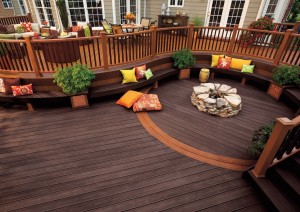 Wood
Wood
Generally, wood is the most common and least expensive of the Superdurables material used for a deck. But if you don’t take care of wood, it can rot, crack, splinter and warp—nails can even pop out of it. If you choose to build a wood deck, it’s recommended that you power wash it twice a year—after the spring pollen season and after the last of the autumn leaves have fallen. You should be able to find a power washing service to help you with this without too much trouble. The next step would be to apply a sealant to the deck’s surface (think of it as applying a protective coating of sunscreen to your deck). Throughout the year, regularly remove debris from your deck and tend to loose boards and splinters when you notice them. Every few years, you’ll need to strip, seal or stain the surface of your deck, for its appearance and longevity.
Keep in mind that the availability of certain woods varies across the country. So, for instance, though redwood is a popular deck choice on the West Coast, it is harder to come by on the East Coast. “In this area, the most commonly used domestic hardwood is pine. Pine is definitely the least expensive material to use for decks here in Virginia, because there’s just so much of it,” says Gordon Cudd of Gordon T. Cudd Construction, Inc.
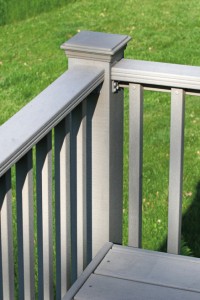 Cedar and pressure-treated pine are favorites for decks because of their budget-friendly price and widespread availability. But, to maintain color and preserve the wood, the decking needs to be treated and sealed because it’s prone to decay and insect infestation. You can expect to replace boards here and there about five to 10 years after the initial installation.
Cedar and pressure-treated pine are favorites for decks because of their budget-friendly price and widespread availability. But, to maintain color and preserve the wood, the decking needs to be treated and sealed because it’s prone to decay and insect infestation. You can expect to replace boards here and there about five to 10 years after the initial installation.
The bottom line: Domestic wood, like cedar and pressure-treated pine, is the least expensive option for deck materials, but will require the most upkeep to keep the deck looking great and protect your investment. Eventually, parts or all of a wood deck will probably need to be replaced. If you’re constructing a deck for the ages, domestic lumber may be a perfect choice. Get in touch with a local lumber dealer to order the decking materials you need.
Tropical hardwoods like ipe have become popular in recent years. Ipe is known for its incredible durability; it is said to last 30 years or more. Cudd says, “In order to keep ipe looking great, a lot of people will oil it annually to bring that color and luster back out.” If left untreated, ipe will weather to gray over time—a look some homeowners prefer. Contact companies like Ipe Decking Georgia if you’re considering Ipe decking materials for your new deck.
You will likely pay more for the material itself, and it is labor-intensive to install because the wood is so dense. In other words, your contractor will spend a lot of time counter-sinking the fasteners, burning through many drill bits and saw blades during the installation of an ipe deck. However, when you consider its long-term durability and comparative ease of maintenance, it may be a wash in the end, as tropical hardwoods have better rot- and insect-resistance than their domestic wood counterparts.
The bottom line: Tropical hardwoods are the most expensive materials option for decks—costing more than other woods or top-of-the-line plastic and composite materials. Tropical hardwoods are heavy and difficult to install. But decks made of tropical hardwoods stand up extremely well to insects and environmental conditions, so once it’s installed, it will likely stand firm for many years to come.
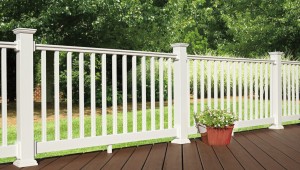 Plastic
Plastic
Manufacturers boast plastic decking materials’ resistance to stains and grease, an important consideration if your deck will be used primarily for grilling and dining. No decking material is completely maintenance free, but plastic may be the closet thing to it. Most plastics are treated with an applied finish and will need only to be washed with a mild detergent and garden hose or power washer.
Jason Nuckols of The Vinyl Porch Rail Company installs decks, railings, pergolas and other outdoor structures using vinyl, a type of plastic polymer. Also called PVC, short for its laboratory name of polyvinyl chloride, this product is generally appreciated for its lifetime warranty and the durability advantage it holds over other materials. Nuckols explains, “PVC has no organic matter; the core of it is recycled material and the hard outer shell allows [manufacturers] to emboss wood-grain patterns into the product. PVC won’t degrade, expand or contract in changing temperature and humidity conditions.”
Keep in mind that plastic is the least heat-resistant material of the three options. So before you choose it for your deck, consider if it will be in the sun for the majority of the day.
Also note that plastic decking isn’t as stiff as lumber, so it generally needs more support underneath it to prevent sagging. The cost per square foot of the material itself is comparable to that of a tropical hardwood, but the installation costs will likely be higher than other options, because the supporting structure of a plastic deck will need to be more extensive. Nuckols says his favorite brand names for PVC decking materials are Azek and Paldek.
The bottom line: Though more expensive than any wood and (most) composite materials, a deck made from plastic could be the closest thing to “carefree” a homeowner can get. As long as your deck isn’t in full sun or without a shade-providing structure, a deck made from plastic decking material may offer an ideal outdoor spot for hassle-free lounging.
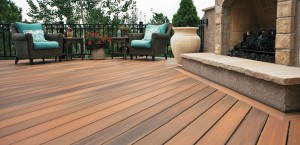 Composite
Composite
For years, “Trex” was the only name in composite deck materials, but now TimberTech, Fiberon and many more companies join it. Composite decking is a hybrid product, manufactured from wood fiber and plastic to form a plank that requires less maintenance and typically has a longer lifespan than natural wood decking. Like plastic decking materials, you won’t have to stain or treat composite decking to maintain its good looks. Nuckols says, “The technology for decking materials has come so far. Today’s materials have excellent stain resistance and wood grain looks that are extremely close to that of real wood.”
Cudd says that today’s composite decking Denver materials have colors, textures and wood grain patterns that look so natural, you’d be hard pressed to tell the difference between natural wood—even tropical hardwoods—and a manufactured product. “They look terrific. If cost weren’t an issue for a homeowner, I would absolutely recommend using a composite decking material for a new deck, hands down,” he says.
Composite boards often come with a warranty of 20 to 25 years and they’ll stay the same color as the day you installed them. Composite is about 40 percent more expensive than real wood initially, but because you don’t have to keep re-staining it, the cost over time can be equal to or less than real wood.
The bottom line: Composite decking materials are a manufactured hybrid of the best qualities of wood and plastic. Composite decking materials carry reasonable guarantees for their long-term performance. If you’re looking for a product that looks like wood but performs over time like only an engineered product can, composite decking is worth your consideration.
Though the cost for deck design, materials and labor will vary, you can expect the amount of time it takes to install an average-sized deck (300 square feet) to be about two weeks. If you’re also adding a porch, pavilion or gazebo, expect it to take at least another week. Such a small investment of time, relatively speaking, will bring your family countless hours and days of relaxation and enjoyment on your new backyard deck.
Azek, Deck Wood, Domestic Hardwood, Fiberon, Gordon T. Cudd Construction, Ipe, Paldek, The Vinyl Porch and Rail Company, TinberTech, Wood Durability






